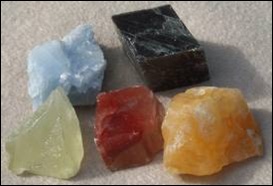Geological History of the Earth /
Geologic Time Scale
The elements or divisions of the (entire) ‘Geological History of the Earth’ (also known as “Geologic Time Scale” or simply “Time Scale”) are given as:
Super-eon Eon Era Period Epoch Age
There is only one Super-eon named Pre-cambrian
Whole the Super-eon i.e. whole the pre-cambrian is sub-divided into Four Eons:
Hadean Eon:
It is the earliest eon in sequence
It existed from 4.5 Ba (billion years ago) to 4 Ba => 0.5 B = 500 M
(ii) Archean Eon:
It existed from 4 to 2.8 Ba => 1.2 B = 1,200 M
(iii) Proterozoic Eon:
It existed from 2.8 Ba to 635 Ma (= 0.635 Ba)
Phanerozoic Eon:
It is the latest eon in sequence; it existed from 635 Ma to 0.012 Ma (=12,000 years ago)
Eons are sub-divided into Eras
Phanerozoic Eon (which is the latest eon in sequence) is sub-divided into Three Eras:
Cenozoic Era, Mesozoic Era and Paleozoic Era
Cenozoic being the latest and Paleozoic being the earliest in sequence
Cenozoic Era is sub-divided into Two Periods:
Quaternary Period and Tertiary Period
Quaternary being the later and Tertiary being the earlier in sequence
Mesozoic Era is sub-divided into Three Periods: Cretaceous Period, Jurassic Period and Triassic Period
Cretaceous Period being the latest and Triassic Period being the earliest in sequence
Paleozoic Era is sub-divided into Six Periods:
Cambrian, Ordovician, Silurian, Devonion, Carboniferous and Permian Periods
Cambrian Period being the earliest and Permian Period being the latest in sequence
Ages of Important Super-eon, Eon, Era, Period and Epoch
Quaternary Period is sub-divided into Two Epochs: Recent Epoch and Pleistocene Epoch
Pliocene Epoch being the latest and Paleocene Epoch being the earliest in sequence
Age:
Precambrian Super-eon existed from about 4.5 Ba (4500 Ma) to about 540 Ma
Phanerozoic Eon existed from 635 Ma to 0.012 Ma {=12,000 years ago})
Cenozoic Era existed from 63 Ma to 12,000 years ago.
Mesozoic Era existed from 230 Ma to 135 Ma
Rock Scale or Formation Scale
Paleozoic Era existed from 650 Ma to 280 Ma
Quaternary Period existed from 2 Ma to 12,000 years ago
Tertiary Period existed from 63 Ma to 2 Ma.
Recent Epoch existed from 12,000 years ago to the present time
Pleistocene Epoch existed from 2 Ma to 12,000 years ago
Rock Scale or Formation Scale
Paleozoic Era existed from 650 Ma to 280 Ma
Quaternary Period existed from 2 Ma to 12,000 years ago
Tertiary Period existed from 63 Ma to 2 Ma.
Recent Epoch existed from 12,000 years ago to the present time
Pleistocene Epoch existed from 2 Ma to 12,000 years ago
MINERALS
Mineral:
Definition: (i) Mineral is a naturally occurring inorganic (chemical) substance
(ii) Having particular physical properties especially particular atomic structure
(iii) And characteristic chemical composition
Minerals are found in earth, waters (especially in sea & ocean waters) and animal and plant bodies
Properties of minerals:
(1): Physical Properties:
Colour:
It is a light dependent property of an object
Colour is a colured or colourless appearance of an object in the light when the it reflects the light or colour is appeared even in darkness when it emits the light
Properties of minerals:
(1): Physical Properties:
Colour:
And colour is chiefly dependent upon the wavelength of wave of the light reflected or emitted from the object
On the basis of colours, minerals are classified into one of the following groups:
(a) Idiochromatic: Having the same characteristics of colour
Having the uniform colour due to the homogeneous mineral composition
Usually the metallic minerals belong to this group
Idiochromatic Minerals 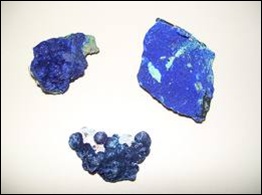
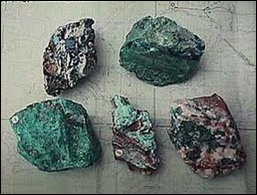
Example: Blue (left) is Azurite (a mineral of bluish copper) and greenish (right) is Malachite (a mineral of greenish copper)
Colour:
(b) Allochromatic: Having variable colours
Variety in colours is generally due to the minute quantity of colour impurifying substances
Usually the non-metallic minerals e.g. calcite, quartz, beryl emerald, pink corundum, etc exhibit this property Calcite 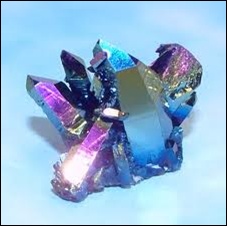 Quartz
Quartz 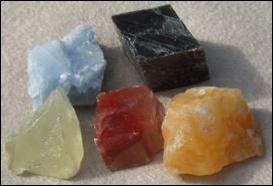
) Pseudo-chromatic: Showing a false or confusing colour
This effect takes place when a mineral is rotated in the hand
It gives a set of colours in succession due to (i) Change of Colour or (ii) Play of Colour
Due to simultaneous reflection and refraction
Due to minute impurifying substances at various locations in a mineral, e.g. Bornite (a mineral of Cu & Fe)
Some particular phenomena concerned with the colour and colouring properties are given as:
Change of Colour: Colours are appeared to change upon the relative movement of a mineral
Some minerals exhibit this phenomenon due to light, heat and certain radiations
Red Realgar (a red arsenic ore) transforms into yellow Paraealgar (a yellow organge arsenic ore)
Cordierite (a mineral of Mg, Fe & Al Silicate) is bluish-purple mineral, turns gray when rotated or viewed at a different angle
(b) Play of Colour: Emission of prismatic colours upon turning about a mineral in light e.g. opal
It is caused by interference of light reflected from various surfaces / crystal-lattice in that mineral, e.g. Cordierite
Opal displays a multicolored effect when viewed from different angles
) Iridescence: Showing of rainbow colours (same as appeared in a drop of oil spilt over water)
Due to refraction or dispersion of light upon reflection from mineral grains/crystal-lattice, e.g. limonite [hydrated FeO(OH)], hematite (Fe2O3), etc
(d) Tarnish: Change of original colours to some secondary colours
Usually due to oxidation of the surface of a metallic mineral, e.g. chalcopyrite (CuFeS2)
Limonite 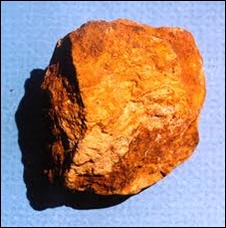 Chalcopyrite
Chalcopyrite 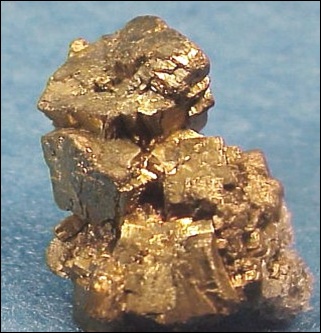 Hematite
Hematite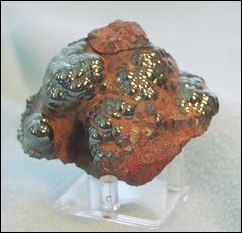
Lustre: It is generally the shine of a mineral
It is the intensity of reflection of light from a mineral’s surface
Due to (i) refractive index (ii) light absorption capacity of a mineral and (iii) nature of light reflecting surface of a mineral. Sapphire – image below (a blue mineral of corundum) – A good example of Lustre:
Poor lustre is due to the reflection from rough surface
Brilliant lustre is due to reflection from smooth surface
Mainly the lustre is classified into:
Metallic, Sub-metallic and Non-metallic Lustre
Metallic Lustre: Shiny or polished appearance of untarnished metallic surface
metallic minerals of sulfides and oxides
Example: hematite (Fe2O3), chalcopyrite,
(2) Sub-metallic Lustre: Giving a look of metallic surface that is dulled by:
Weathering or corrosion
Example: sphalerite (ore of zinc), cuprite (ore of copper), cinnabar (ore of mercury), etc.
(3) Non-metallic Lustre: Non-metallic lustre is further sub-divided into:
Non-metallic Lustre is sub-divided into the following types:
Adamantine Lustre: Lustre of a transparent or translucent mineral having high refractive index
Example: diamond and pearl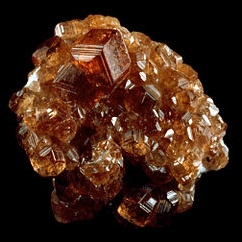
(ii) Dull or Earthy Lustre: Due to coarse granulation
Example: Usually all the clays e.g. Kaolinite (a clay mineral of Al and Si), chalk (a white, porous and soft sedimentary rock), bauxite (an ore of Al), pyroxene (a group of crystalline silicate minerals containing two metallic oxides), etc. 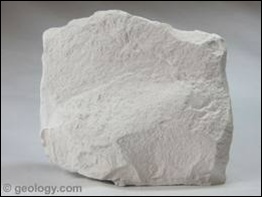
(iii) Greasy Lustre: That gives the look of fatty or greasy surface
Example: opal (an amorphous mineral of silica), cordierite (a Mg, Fe, Al and Si mineral), etc.
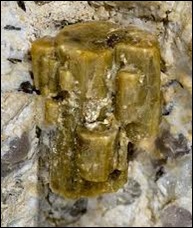
(iv) Waxy Lustre: The surface gives the look of wax or the mineral resembles a chunk of wax
Example: Jade (a matamorphic rock of silicates minerals) and Chalcedony (a crystalline mineral of silica) 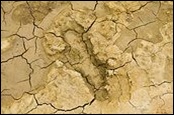
) Vitreous Lustre: Lustre of a mineral shining like a glass or ice
Example: Quartz (A very hard crystalline mineral of silica, SiO2)
Pearly Lustre: Lustre of a mineral looking like a pearl
Example: Labradorite (a blue, green, or reddish-brown feldspar mineral; composed of silicates of Ca, Al and Na)
Resinous Lustre: Lustre of a mineral looking like resin or coal-tar
Example: Nepheline (A mineral of sodium-aluminum or potassium-aluminum silicate)
